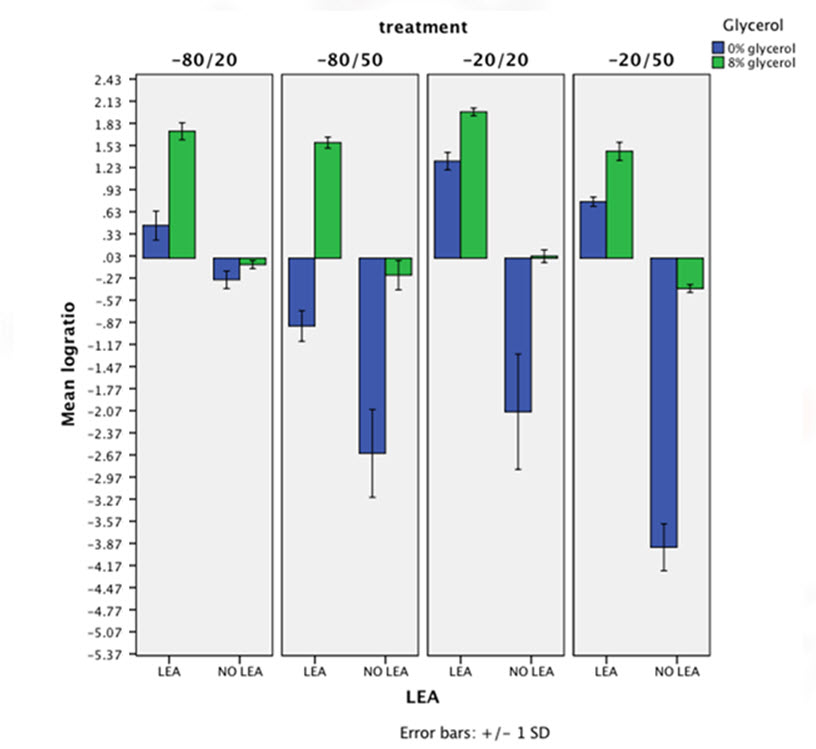Team:Valencia/lea
From 2010.igem.org
Alejovigno (Talk | contribs) |
Alejovigno (Talk | contribs) (→Introduction) |
||
| Line 9: | Line 9: | ||
The fourth part involves dealing with violent temperature changes of the Martian surface. To do this we will implement the expression of LEA (late embryogenesis abundant) “antifreeze” protein. Thus, we want to verify the resistance to cold shock and salt stress of the E. coli cultures who which express LEA and compare this result with the ones who doesn't (control cultures). This brings the new problem of which control cultures we shall use. The same E.coli with the pM2 plasmid but without the insert (this is probably the best option but the more difficult one) What happened with this issue guys??? | The fourth part involves dealing with violent temperature changes of the Martian surface. To do this we will implement the expression of LEA (late embryogenesis abundant) “antifreeze” protein. Thus, we want to verify the resistance to cold shock and salt stress of the E. coli cultures who which express LEA and compare this result with the ones who doesn't (control cultures). This brings the new problem of which control cultures we shall use. The same E.coli with the pM2 plasmid but without the insert (this is probably the best option but the more difficult one) What happened with this issue guys??? | ||
| + | |||
| + | |||
| + | <html> | ||
| + | <div class="center"><div class="thumb tnone"><div class="thumbinner" style="width:502px;"> | ||
| + | <object classid="clsid:d27cdb6e-ae6d-11cf-96b8-444553540000" codebase="http://download.macromedia.com/pub/shockwave/cabs/flash/swflash.cab#version=9,0,0,0" width="300" height="246" id="Valencia_priones" align="middle"> | ||
| + | <param name="allowScriptAccess" value="sameDomain" /> | ||
| + | <param name="allowFullScreen" value="false" /> | ||
| + | <param name="movie" value=" | ||
| + | https://static.igem.org/mediawiki/2010/3/3f/Valencia_lea14.swf" /><param name="quality" value="high" /><param name="bgcolor" value="#ffffff" /> <embed src=" | ||
| + | https://static.igem.org/mediawiki/2010/3/3f/Valencia_lea14.swf" quality="high" bgcolor="#ffffff" width="300" height="246" name="baner_final_sin_btn" align="middle" allowScriptAccess="sameDomain" allowFullScreen="false" type="application/x-shockwave-flash" pluginspage="http://www.macromedia.com/go/getflashplayer" /> | ||
| + | </object> | ||
| + | <div class="thumbcaption"><b>LEA14</b> Three dimensional representation of the LEA14 proteinn.(EPDB)</div></div></div></div> | ||
| + | </html> | ||
==Late Embriogenesis Abundant (LEA) protein== | ==Late Embriogenesis Abundant (LEA) protein== | ||
Revision as of 15:08, 27 October 2010
Time goes by...
(El tiempo pasa...)
Follow us:

Our main sponsors:

Our institutions:

Visitor location:
» Home » The Project
Surviving on Mars
Introduction
The fourth part involves dealing with violent temperature changes of the Martian surface. To do this we will implement the expression of LEA (late embryogenesis abundant) “antifreeze” protein. Thus, we want to verify the resistance to cold shock and salt stress of the E. coli cultures who which express LEA and compare this result with the ones who doesn't (control cultures). This brings the new problem of which control cultures we shall use. The same E.coli with the pM2 plasmid but without the insert (this is probably the best option but the more difficult one) What happened with this issue guys???
Late Embriogenesis Abundant (LEA) protein
LEA proteins: characteristics and function
The LEA (Late Embryogenesis Abundant) proteins were discovered about thirty years ago and were identified as proteins that highly accumulate during the maturation of cotton embryogenesis (Dure and Chlan (1981), Plant Physiol. 68: 180-186). Between their common characteristics, we can point out their high hydrophilicity, the abundance of some amino acid residues such as Gly, Ala, Thr, Glu and Lys/Arg, and their probable intrinsic lack of tertiary structure (Battaglia et al. (2008), Plant Physiol. 148: 6-24). Although these proteins are known for their role in preventing dehydration in plants, they can be found in many distant branches of the tree of life, like in algae, animals, fungi, archaea and bacteria (Tompa and Kovacs (2010), Biochem. Cell. Biol. 88: 167-174).
Experiments
We carried out several experiments ...
 "
"
